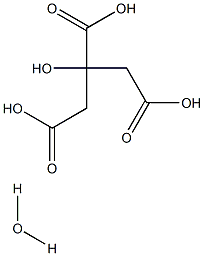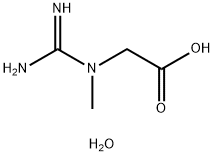Betaine monohydrate
- CAS NO.:590-47-6
- Empirical Formula: C5H13NO3
- Molecular Weight: 135.16
- MDL number: MFCD00150010
- EINECS: 209-684-7
- SAFETY DATA SHEET (SDS)
- Update Date: 2024-08-19 22:38:46

What is Betaine monohydrate?
Chemical properties
WHITE CRYSTALS OR CRYSTALLINE POWDER
The Uses of Betaine monohydrate
Betaine monohydrate has been used:
- in the preparation of KLA buffer to perform polymerase chain reaction (PCR)
- to study the its effects on Km and Vmax of human aldose reductase
- to study its effects on the growth of A549 lung cancer both in vitro and in vivo
What are the applications of Application
Betaine monohydrate is a general methyl donor
Definition
ChEBI: A hydrate that is the monohydrate form of glycine betaine.
General Description
Betaine is a zwitterionic quaternary ammonium compound and is mainly present in animals, microorganisms and plants. It is one of the main constituent of several food items like wheat, shellfish, spinach and sugar beets. It is also termed as trimethylglycine, lycine, glycine betaine and oxyneurine. Betaine is a methyl derivative of glycine. It has a molecular mass of 117.2.
Biochem/physiol Actions
End-product of oxidative metabolism of choline, betaine is a general methyl donor, in particular in a minor pathway of methionine biosynthesis. It is used to treat homocystinuria, which is a defect in the major pathway of methionine biosynthesis.
Purification Methods
Crystallise betaine from aqueous EtOH or EtOH/Et2O. The monohydrate loses H2O above 100o. Betaine undergoes internal alkylation to methyl dimethylaminoacetate Purification of Biochemicals — Amino Acids and Peptides above its melting point. It is also prepared by treating the hydrochloride (below) with silver oxide and recrystallising from EtOH/Et2O. [Edsall J Am Chem Soc 66 1767 1943, Leifer & Lippincott J Am Chem Soc 79 5098 1957, for pK see Grob et al. Chem and Ind (London) 1222 1955, Beilstein 4 III 1127, 4 IV 2369.]
Properties of Betaine monohydrate
| storage temp. | 2-8°C |
| solubility | H2O: 0.1 g/mL, clear, colorless |
| Water Solubility | SOLUBLE. >100 g/100 mL |
| Merck | 13,1182 |
| BRN | 3626258 |
| CAS DataBase Reference | 590-47-6(CAS DataBase Reference) |
Safety information for Betaine monohydrate
| Signal word | Danger |
| Pictogram(s) |
 Corrosion Corrosives GHS05  Exclamation Mark Irritant GHS07 |
| GHS Hazard Statements |
H302:Acute toxicity,oral H318:Serious eye damage/eye irritation |
| Precautionary Statement Codes |
P264:Wash hands thoroughly after handling. P264:Wash skin thouroughly after handling. P270:Do not eat, drink or smoke when using this product. P280:Wear protective gloves/protective clothing/eye protection/face protection. P501:Dispose of contents/container to..… |
Computed Descriptors for Betaine monohydrate
New Products
4-(Dimethylamino)tetrahydro-2H-pyran-4-carbonitrile 4-AMINO-TETRAHYDRO-PYRAN-4-CARBOXYLIC ACID 4-Aminotetrahydropyran-4-carbonitrile Hydrochloride (R)-3-Aminobutanenitrile Hydrochloride 4-AMINO-TETRAHYDRO-PYRAN-4-CARBOXYLIC ACID HCL 3-((Dimethylamino)methyl)-5-methylhexan-2-one oxalate 5-Bromo-2-nitropyridine Nimesulide BP Aceclofenac IP/BP/EP Diclofenac Sodium IP/BP/EP/USP Mefenamic Acid IP/BP/EP/USP Ornidazole IP Diclofenac Potassium SODIUM AAS SOLUTION ZINC AAS SOLUTION BUFFER SOLUTION PH 10.0(BORATE) GOOCH CRUCIBLE SINTERED AQUANIL 5 BERYLLIUM AAS SOLUTION Methylcobalamin (vitamin B12) SODIUM METHYL PARABEN SODIUM VALPROATE AMOXICILLIN (AMOXYCILLIN) TRIHYDRATE ACICLOVIRRelated products of tetrahydrofuran








You may like
-
 Betaine monohydrate, 99% CAS 590-47-6View Details
Betaine monohydrate, 99% CAS 590-47-6View Details
590-47-6 -
 Betaine monohydrate CAS 590-47-6View Details
Betaine monohydrate CAS 590-47-6View Details
590-47-6 -
 Betaine monohydrate CAS 590-47-6View Details
Betaine monohydrate CAS 590-47-6View Details
590-47-6 -
 1823368-42-8 98%View Details
1823368-42-8 98%View Details
1823368-42-8 -
 2-(3-(tert-butyl)phenoxy)-2-methylpropanoic acid 1307449-08-6 98%View Details
2-(3-(tert-butyl)phenoxy)-2-methylpropanoic acid 1307449-08-6 98%View Details
1307449-08-6 -
 Ethyl 3-(furan-2-yl)-3-hydroxypropanoate 25408-95-1 98%View Details
Ethyl 3-(furan-2-yl)-3-hydroxypropanoate 25408-95-1 98%View Details
25408-95-1 -
 2-Chloro-5-fluoro-1-methoxy-3-methylbenzene 98%View Details
2-Chloro-5-fluoro-1-methoxy-3-methylbenzene 98%View Details
1805639-70-6 -
 Lithium ClavulanateView Details
Lithium ClavulanateView Details
61177-44-4